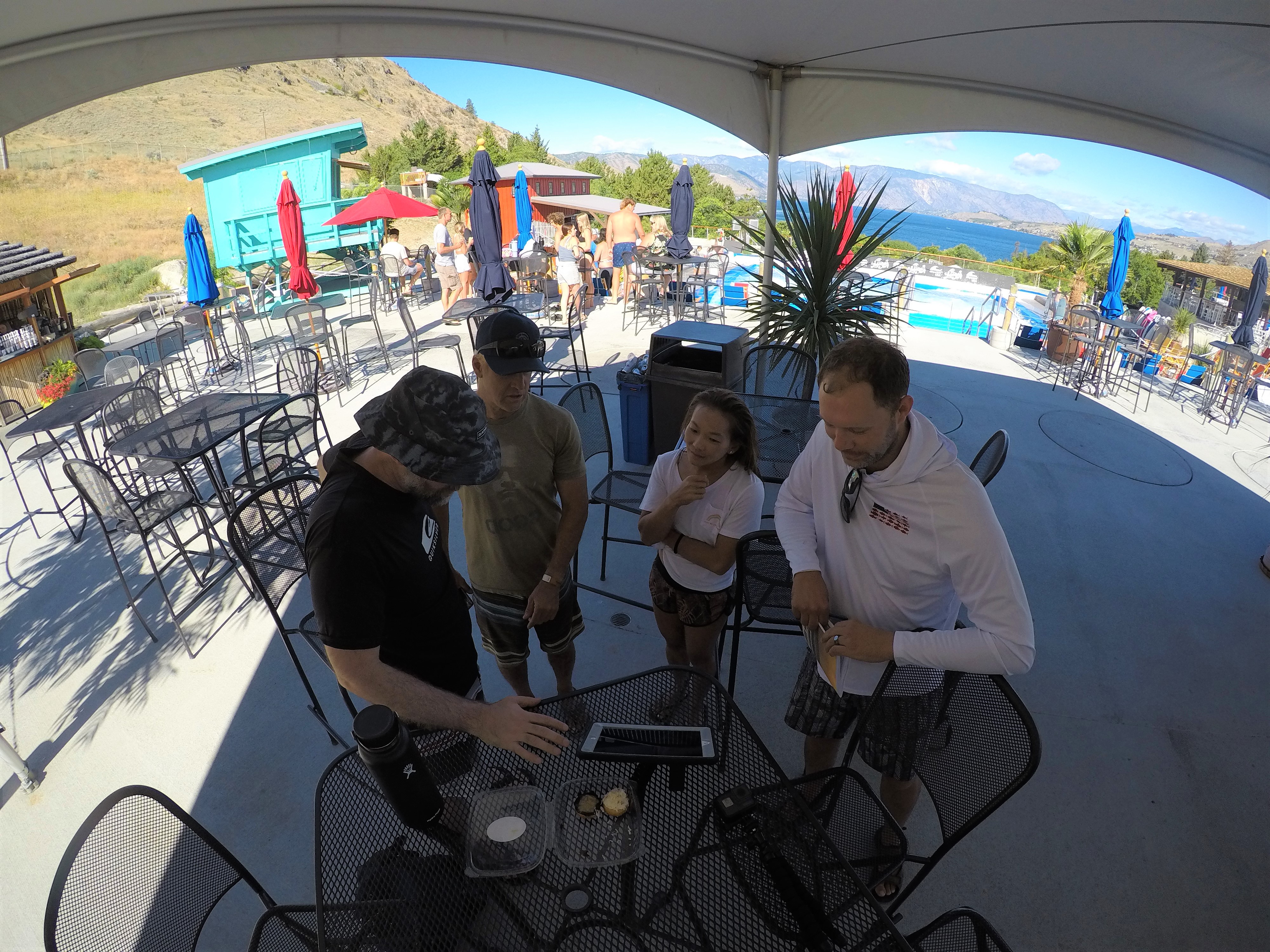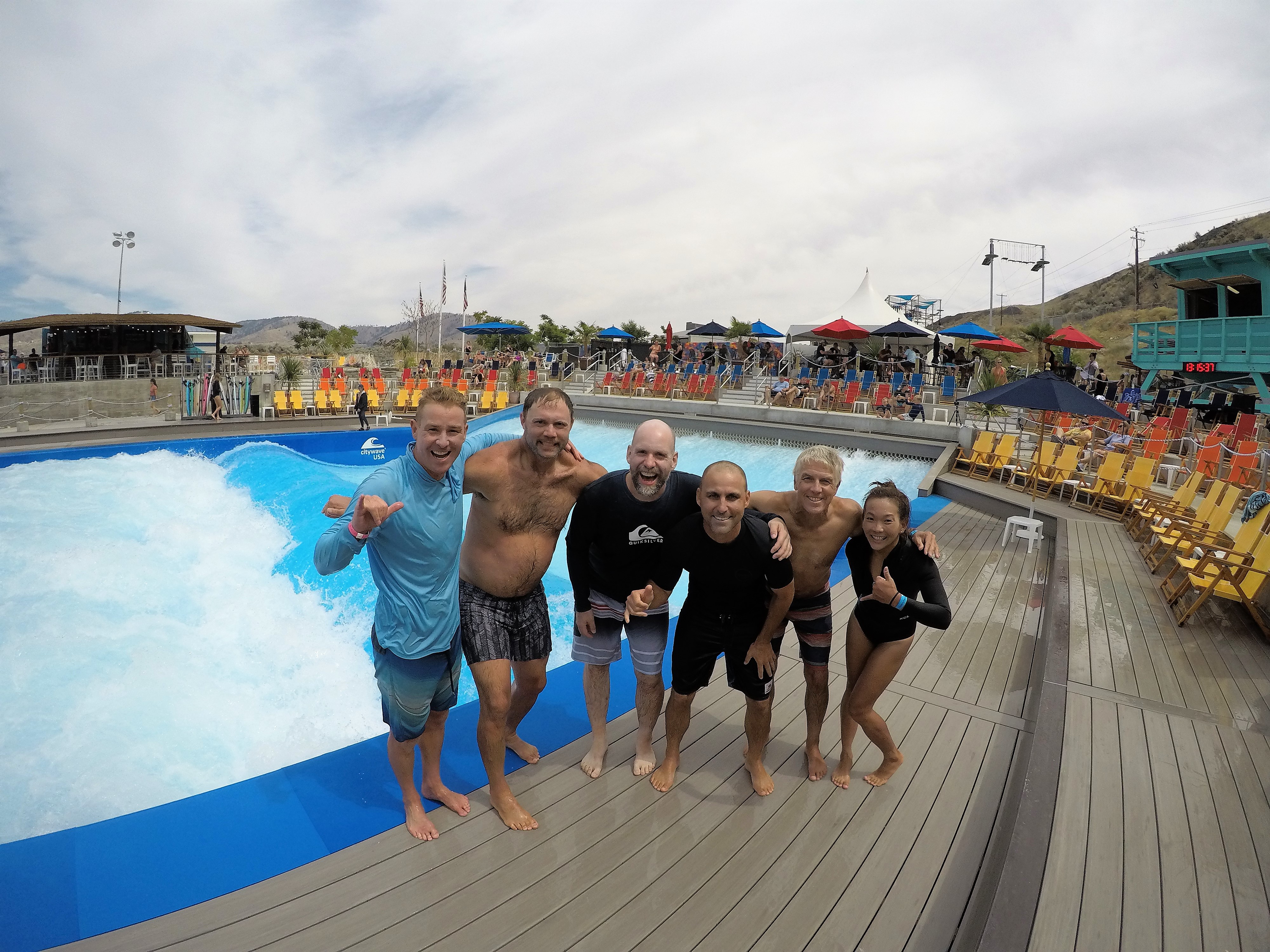From a Down the Line to a Carving Surfer … in 3 Days

The Progression
Barry turns to me and says, “who is this guy?!?”
The surfer in reference is a client of ours whose surfing did a complete transformation in the 3 days we visited Lakeside Surf in Washington for a co-coaching trip. Body movement coordination had changed, confidence increased, and the speed at which these things happened was incredibly fast.
The trip was simple. 3 days, 5 private sessions on the wave, video review, paddling review in the lake, Q&A, and any extra public sessions the group wanted to add on. Barry would cover riding the wave. I would cover paddling, and we’d all have a fun little surf trip.
Barry and I felt confident based on our own experience that this wave could help surfers progress their technique and get more riding time. But we weren’t expecting that it would move the needle as much as it did.
The surfers turned from down the line focused surfers to carving surfers, or surfers beginning the mechanics of carving. Surfers began to work on flow, style, and creativity. And it became increasingly fun with each successive session.
Barry and I expected some progression. But based on our last trip there, we didn’t expect this much progression in such a short amount of time. The reason has something to do with learning the wave itself, and how long that takes before the surfer can let loose and work on surf maneuvers.

The Wave – Learning Curve
When Barry and I visited Lakeside Surf last summer, we signed up for 5 public sessions (4 for Barry). A public session is one with other surfers and can fill up to a maximum of 12 surfers. So we were 2 of 12 surfers.
The wave is humbling. I thought we’d roll in, get a few waves on their foamies, then break out our real surfboards and rip the snot out of the wave. Boy was I wrong. In a big way.
There is a learning curve to just the wave itself. It feels different at first. Building speed is slightly different than on an ocean wave, and the entire environment is just weird in the eyes of an ocean surfer. We had not accounted for that and quickly had to reset our brains to go into learning mode.
For Barry and I, the wave started to make sense in our 4th sessions. We began creating speed, becoming more comfortable with the new sensation and environment, and began carving back and forth with control. This is when I would say the wave “clicked”.
For the surfers on our most recent trip, they said they started to feel comfortable in Session 2 and 3.
Why the difference?
Being the nerd I am, I compiled statistics on number of waves ridden and time surfing for each session we had.
Our most current trip statistics:
- Each private session duration = 45 minutes
- 5-6 surfers per session (2 coaches, 3-4 participants)
- Waves ridden
- Total = 317
- Average waves per session = 63.4
- Average waves per surfer per session = 11.79
- Minimum waves in a session by a surfer (non-coach) = 11
- Maximum waves in a session by a surfer = 18
- Time Surfing (actually on feet riding)
- Total = 145 minutes
- Average riding time per surfer = 29 minutes 1 second
- 64% of the duration of the session was spent on feet
- The remaining time was wiping out and the next surfer setting up
- Average riding time per surfer per session = 5 minutes 23 seconds
- Average time on wave = 27 seconds
- Minimum riding time in a session by a surfer (non-coach) = 2 minutes 48 sec
- Minimum average riding time on wave (non-coach) = 15 seconds
- Shortest ride (non-coach) = 1 second
- Maximum riding time in a session by a surfer (non-coach) = 10 minutes 49 sec
- Maximum average riding time on wave (non-coach) = 46 seconds
- Longest ride (non-coach) = 2 minutes 43 seconds
There are loads of fantastic data here but let’s just focus on the number of waves to explain why the surfers in our most recent trip “clicked” during Sessions 2 and 3 whereas Barry and I “clicked” at Session 4. And it has nothing to do with how good a surfer you are. It has more to do with how our brains work.
If we just take the average number of waves per surfer per session (11.79), we’ll be able to explain this.
With our private sessions, with only 5-6 surfers per heat, here are the totals as each surfer progressed from one session to the next (using the average number of waves per session):
- Session 1 = 11.79 waves
- Session 2 = 23.58 waves (11.79 x 2)
- Session 3 = 35.37 waves (11.79 x 3)
- Session 4 = 47.16 waves (11.79 x 4)
- Session 5 = 58.95 waves (11.79 x 5)
For Barry and I last summer, our average wavecount was much lower because we were in public sessions with 10 other surfers. Using our total wavecount of 317, dividing it by 5 sessions and then again by 12 surfers, we get an average wavecount of 5.28 waves per surfer.
Here would be the totals for Barry and I:
- Session 1 = 5.28 waves
- Session 2 = 10.56 waves (5.28 x 2)
- Session 3 = 15.84 waves (5.28 x 3)
- Session 4 = 21.12 waves (5.28 x 4)
- Session 5 = 26.4 waves (5.28 x 5)
Notice how Barry and I started to feel more comfortable when we reached the 20-30 wave range (in Session 4-5), and the surfers in the most recent trip started to feel more comfortable when they reached the 20-30 wave range Session 2-3.
And everyone’s surfing looked different at that point. They began exploring the wave more vertically, opening up the body more, and became more relaxed.
This conclusion definitely points us to our simple, yet beautiful answer to how long it takes for an ocean surfer to become comfortable on the wave – our baseline – before we will feel like we can begin working on “surf” maneuvers and technique.
But this is when the real magic started…

How The Progression Happened So Quickly
Motor learning studies point very clearly to how to improve motor skills – quality repetition. Surfing has always presented a challenge to this because of how little time we spend actually riding waves (especially at the beginning of learning), and how each wave acts differently, effectively providing us with a completely different canvas each time we get up on the wave.
Enter wavepools. Wavepools have increased ride time and allowed a more consistent canvas for surfers to work on the basics of wave riding.
The Lakeside Surf wave creates a specific part of surfing – it doesn’t cover everything. I was trying to explain to one of the instructors at Lakeside, who has never ocean surfed, what the ocean experience is like.
“90% of surfing’s active time is paddling. Of the remaining 10%, I would estimate that 10% of that is cutting back like they do on the Lakeside wave. So we’re only seeing 1% of surfing right here in front of our eyes.” (I didn’t factor in other skills like trimming, pumping, and check turns that we saw at Lakeside).
At the end of the day, just having time on our feet helps our surfing. But to speed up this process, incorporating an immediate feedback loop is critical to motor learning.
At Lakeside, after a surfer falls, Barry, myself, or a Lakeside instructor had the opportunity to speak immediately to that surfer about something they saw or wanted the surfer to work on. It was literally seconds after they fell. Then they only had to wait about 3 minutes before they were on the wave again.
In addition, while the surfer was surfing, each instructor or coach could give them encouragement when they were close to each side of the pool. Basically live instruction.
Lastly, Barry conducted a video review session before and after sessions which allowed the surfers to visibly see what their body position was and where they were on the wave in relation to how they felt on the wave.

The immediate feedback loop I saw go down there was similar to my Endless Pool feedback loop when I work with surfers on paddling. It’s practically instantaneous. This kind of feedback loop is difficult to impossible in the Ocean environment and even significantly slower at other wave pools. A similar feedback loop is present in those other places, but it takes longer because the heat needs to be finished, or the surfer needs to come into the beach to review.
On top of all of this, the surfer gets time on their feet – even without coaching this is extremely valuable.
12 waves per 45 minute session with an average ride time of 27 seconds on each wave. That’s a super long ride. The average total time riding per surfer was 29 minutes! That means that in five 45-minute sessions (3 hours 45 minutes total), they were able to accomplish what would take them months in the ocean considering most ocean rides last at most 5 seconds.
Finally, in our private sessions, we were able to customize the wave. There are different settings on the Lakeside wave and we were able to slow the current down until surfers were more comfortable with the wave. Another variable was the ability to increase or decrease the height of the wave. This allowed us to progress in a structured manner, moving forward when we were ready to move forward in the process.
When we factor in all of these advantages – immediate feedback loop, number of waves ridden, time riding, and the customization of the wave – we realize why these surfers progressed so quickly.

The Aftermath
But how does this all translate to the Ocean?
After last year’s trip, I felt a difference immediately in shifting to my back foot sooner than I had before. It was a small change in my surfing that had profound results in my turns and speed generation coming out of the turns. I certainly felt a difference. But I’m bias, right?
So we polled our surfers from this trip. Here’s a response from one:
“Feel like the wave pool did give me more confidence in the water, I felt I was surfing better today and was making the most of 3' beach break.
The wave pool definitely helped me get my upper and lower body working together (I believe Barry was talking about this), and I feel at least for myself I have a better idea of how to position myself on the board. Not sure if that's helpful, but just wanted to let you know that I'm already feeling results.”
Next trip…
I hope you enjoyed this write up and it gave you some ideas on how to progress your surfing. I’ll be planning another trip to Lakeside Surf, maybe a few more, because I see it helping me with my own surfing, and I can also conduct paddling review in the lake while we work with a Technique Surf Coach like Barry on the wave.
If you want to be included in the invitation to the next co-coaching trip to Lakeside Surf, please send me an email [email protected] and let me know.
In the meantime, I’ll see you in the water…

Get Free Training, Quick Tips, News and Updates with the monthly newsletter!
Join our mailing list to receive the latest news and updates. Your information will not be shared.
